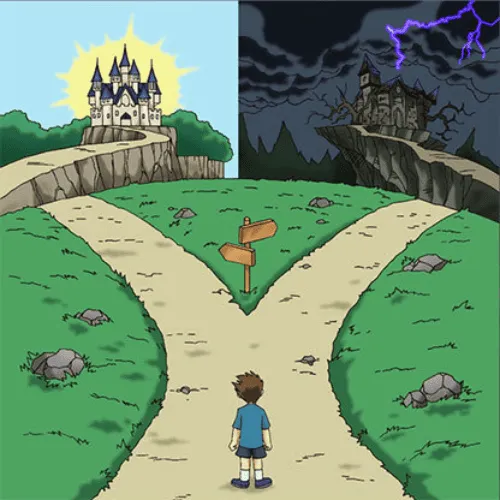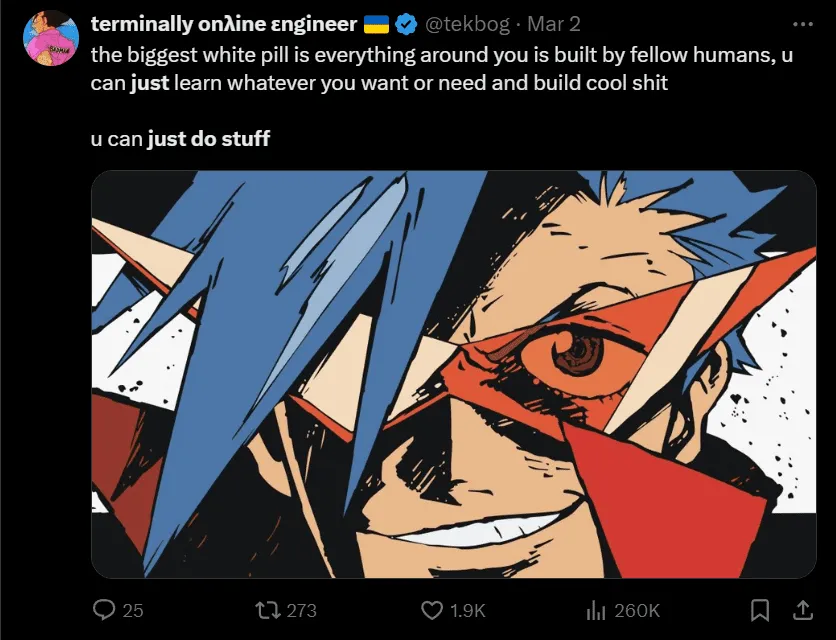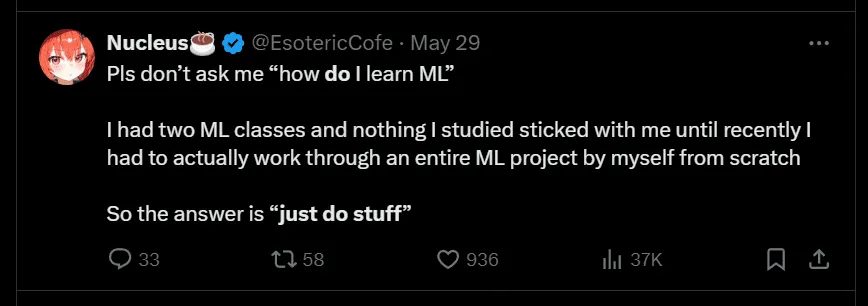The Thought Process Behind My Learning Plan
About six months ago, I decided to switch from marketing to coding. To make the switch, I would need to map the territory.
After binge-watching countless YouTube videos and soaking in all the advice I could find, I decided to read a book called Machine Learning with PyTorch and Scikit-Learn.
But soon after, I hit a wall. I realized that to truly grasp the algorithms discussed in the book, I needed a solid foundation in mathematics.

That marked the beginning of my math grind.
First Course Correction

I had a clear direction in mind: Khan Academy would be my gateway to mastering the essentials. But, like a ship navigating uncharted waters, I soon found myself altering course.
Within 30 days, I pivoted to full-fledged university courses, introduced a textbook ten days later, and ultimately signed up for Math Academy, scrapping every resource I previously carefully collected.
This constant change might seem like a lack of strategy.
I strongly disagree.
Your North Star and the 10,000 Hour Rule
In marketing, there’s a discussion about the “North Star Metric” (NSM)—a fixed point that guides you through the fog, much like a ship’s compass in a storm.
It’s your long-term vision, the one metric that matters, steering you toward success.
When building a learning roadmap, the NSM is equally critical. It helps you stay focused on your ultimate goal, even as you make necessary adjustments along the way.
But how do you decide what your North Star is? And what was mine?
For me, the North Star was simple: start a company and build fun, cool-ass products that make money. I wasn’t interested in research for the sake of research or advancing humanity’s frontier.
Structured in the Macro, Chaotic in the Micro

My approach to building a roadmap is to set a big goal, break it down into milestones, and then attack those milestones with daily intensity.
I believe in being structured in the macro—having a clear overall direction—while embracing chaos in the micro, the day-to-day.
I don’t worry if my roadmap isn’t perfect.
Instead, I focus on putting in the work, clocking those 10,000 hours (not that it’s required to reach mastery).
As Tim Ferriss once scoffed at Malcolm Gladwell’s “10,000 Hour Rule,” it’s not just about the number of hours but how you use them.
Do I have everything planned out at every moment? Absolutely not.
I give myself the freedom to do what feels right day-to-day, but I keep it real with myself—understanding what actually moves the needle versus what is just procrastination.
Why It’s Okay to Make Big Changes to the Plan
This year, I shifted my focus multiple times, and you might think that reflects poor planning. But the truth is, it’s entirely expected that your first plan of attack isn’t the best.
Why? Because you lack information. As you gain more insights, you naturally iterate and improve the plan. But there’s another reason I often make learning detours: to avoid burnout.
Sometimes, I find myself slowing down, losing enthusiasm, and feeling stuck—especially when the work becomes challenging, and progress feels slow, like when math started to get really tough.
A great way to reset and refresh is to shift gears and do something completely different.
For example, after my first two months of intense focus, I decided to take a break and dive into something new: I installed Linux, learned the command line, and got familiar with Git and GitHub.
ML progress report (days 55 & 56)
— Lelouch 👾 (@lelouchdaily) May 2, 2024
Current stage: Git & Linux
Learned for: 2h yesterday & 4h today
Satisfied? Yup
Got curious about Linux and Git/GitHub, so will be learning it next few days. Traveled the last two days (tomorrow, too), so have limited opportunity to study. pic.twitter.com/NL97mZ58Fx
It was a complete change of pace that allowed me to return to my main goals with renewed energy.
I’m currently doing this again by learning web development, which helped me build this website and will eventually help me build bad-ass user experiences. This change isn’t a distraction; it’s an intentional shift that keeps me engaged and prevents burnout.
The name of the game is QUICK ITERATION. It’s not about sticking rigidly to a plan; it’s about adapting as you learn more, updating your approach, and continually refining your strategy.
Need a Checklist?
So, how do you actually go about designing your own learning roadmap? Here’s an approach that has worked for me:
-
Define the End Goal: What do you want to achieve? Whether it’s becoming a full-stack developer, mastering machine learning, or something else entirely, you need to have a clear destination in mind.
-
Identify the Skills Needed: What skills do you need to reach your goal? A good idea is to start mapping the territory, which means consuming as much information as possible across various sources to get a big picture of the state of the industry/field. You will not only identify the key players, companies, and technologies, but you will also learn the vocabulary & terminology used (WHICH IS CRUCIAL FOR FURTHER RESEARCH).
-
Start Mapping the Field: Open a notepad (or something more sturdy) and start writing the list in bullet points. Make sure you put everything on paper—just brain-dump it. Don’t worry about the order; the goal is to get all your thoughts out.
-
Decide Your Learning Style: Are you a top-to-bottom or bottom-to-top learner? I personally prefer top-to-bottom because it gives me an idea of what I’m learning for. This approach lets you understand the broader picture before diving into the nitty-gritty.
-
Break It Down into Milestones: Once you’ve mapped out what you need to learn, break it down into smaller, manageable milestones. These milestones should be challenging yet achievable so you can build momentum and feel a sense of accomplishment as you progress.
-
Stay Flexible: Your roadmap is a guide, not a rigid set of instructions. Be ready to make changes based on new information and insights.
The key is to keep moving forward, even if that means adjusting your course.
- Iterate Quickly: Don’t be afraid to pivot or refine your plan. You’ll naturally discover better ways to reach your goal as you learn more. The faster you iterate, the quicker you’ll find what works best for you.
Final Thoughts
One of my favorite quotes by Abraham Lincoln is:
“Give me six hours to chop down a tree, and I will spend the first four sharpening the axe.”
It emphasizes the importance of having the right plan and using the right tools.
BUUUUUT
Avoid getting stuck in analysis paralysis.
You’re not an expert lumberjack just yet, and that’s okay.

The most common message I receive in my DMs is from people paralyzed by uncertainty, unsure of where to start, and wasting precious hours that could’ve been spent taking action.
What action? ANY action.
When you’re just starting out, you don’t have all the information you need to craft the perfect plan.
And you don’t need to. The key is to run with what you’ve got.
As you encounter your first roadblocks and identify new ways to improve, remember your North Star. Stay focused on your ultimate goal, but don’t be afraid to make adjustments along the way.
Progress is more important than perfection.
So, sharpen your axe as best as you can, but when the time comes, start chopping!
The path will become clearer with each swing.